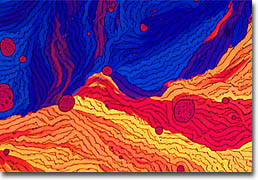The Phytochemical Collection

Sulforaphane
Phytochemicals
|
For more information and additional photomicrographs, visit our Phytochemicals gallery of digital images made with recrystallized plant biochemicals. Over the course of the last century, the pharmaceutical industry has produced a number of synthetic drugs to help combat and prevent disease. However, despite such innovations, increasing evidence suggests that the best means of ensuring good health may be much easier to come by, since a trip to the local produce stand or even to one's own backyard garden may be enough to secure them. Indeed, parental intuition has led many a mom and dad to urge their children to eat their fruits and vegetables throughout history, but the wisdom of this advice has only begun to be fully understood. Edible plants, research over the last few decades has revealed, are not only valuable to humans for their nutrient value, but also for the array of health benefits certain nonnutritive bioactive substances they contain may impart. Dubbed phytochemicals, these substances have been of intense interest among the scientific community in recent years and are blazing a new frontier in the arena of disease-prevention research. 
Ellagic Acid In plants, phytochemicals serve as a means of defense and are believed to have first evolved in order to help them adjust to changes in the Earth's atmosphere. When the earliest plants appeared on the planet, only a small amount of free oxygen was present in the atmosphere. Due to the metabolic processes of plants, however, which take in carbon dioxide and emit oxygen, the Earth's atmosphere began to alter, oxygen levels increasing to such an extent that the environment became polluted and difficult for plants to live in. Over time, in order to survive, some plants developed a number of antioxidant compounds that offered them protection from highly reactive molecules of oxygen. These better-equipped plants endured, and over the course of many more years evolved into the oxygen tolerant plants that are familiar today. Similarly, over the ages, plants developed biochemical means of protection from a number of other environmental hazards such as viruses, bacteria, and fungi that could affect their chances for survival. Many of these same substances, it has been discovered, may offer protection to animals, including humans, when they are consumed in the diet. 
Phenethyl Isothiocyanate Phytochemicals are found in a wide array of plants and are most commonly consumed in foods and beverages such as fruits, coffee, green tea, garlic, green peppers, red wine, onions, yogurt, bran, and cruciferous vegetables. These edible items each tend to contain a wide variety of phytochemicals as well, often providing a multiplicity of health benefits. A single orange, for instance, typically contains more than 170 identifiable phytochemicals, which include large groups of flavonoids, limonoids, carotenoids, and terpenoids. Each of these assemblies of biochemicals has been associated with certain beneficial properties, some of which overlap between groups. Flavonoids, for instance, have been found to demonstrate anti-inflammatory, antitumor, and antioxidant activity, while limonoids have diuretic, antimutagenic, and anticarcinogenic effects. Correspondingly, carotenoids have antioxidant capabilities and reduce or inhibit mutagenesis in cells, and terpenoids reduce low-density lipoprotein (LDL) cholesterol levels and act as anticarcinogens. Thus eating oranges may bestow low levels of all of these protective qualities to those that consume them. 
Capsaicin Although the potential for health benefits from phytochemicals is broad, many consider their chief advantage to be their anti-cancer activity. One of the most heavily studied phytochemicals in this regard is sulforaphane, a small molecule that is featured in our banner photomicrograph. Found in significant quantities in broccoli and broccoli sprouts, studies have shown that sulforaphane expedites the excretion of carcinogens from cells. Also present in broccoli is a biochemical known as phenethyl isothiocyanate (PEITC), which prevents carcinogenic polyaromatic hydrocarbons from intercalating with DNA and causing mutations, as well as indole-3-carbinol, an indole derivative that aids in the metabolism of estrogens. Thus, broccoli appears to be one of the most powerful dietary ways to help ward off cancer, despite the vegetables often negative reception at the dinner table. Of course, for those who truly dislike broccoli to such an extent that they vow to avoid it, such as George Bush did during his presidency of the United States, there are other options. Tomatoes, strawberries, pineapples, and green peppers, for example, have relatively high concentrations of p-coumaric acid and chlorogenic acid, two chemicals that reduce the production of nitrosoamines, thus reducing potential for carcinogenic activity. 
Catechin Hydrate Despite the apparent advantages of consuming phytochemicals, many of these substances are still being evaluated for their safety and effectiveness. Yet, it is widely accepted that there is not any danger of overconsumption of phytochemicals when consuming them in the diet from natural foods. Concern arises, however, when phytochemicals are extracted from plants and are compounded in an artificial supplement form. These compounds are not always beneficial under all circumstances or in high doses. Certain biochemicals and vitamins as provided in supplements, for example, have been found to encourage the growth of cancer cells, and their use is being discouraged in patients undergoing cancer treatments. More specifically, the highly touted phytochemical beta-carotene, although it has many benefits in other circumstances, has been associated with an increased risk of lung cancer in male smokers when consumed via supplements in large quantities. |
© 1995-2025 by Michael W. Davidson and The Florida State University. All Rights Reserved. No images, graphics, software, scripts, or applets may be reproduced or used in any manner without permission from the copyright holders. Use of this website means you agree to all of the Legal Terms and Conditions set forth by the owners.
This website is maintained by our
|